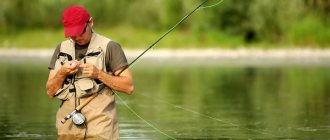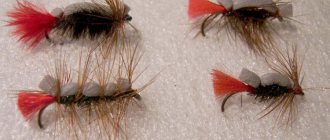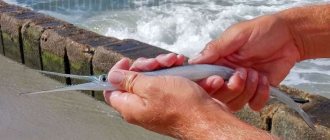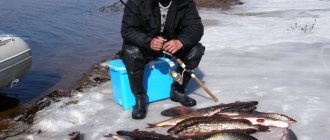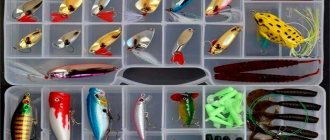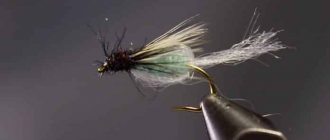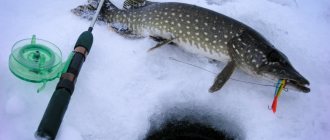Tackle for roach
Two types of tackle are used: a float rod and a fishing rod with a nod. Freezing of the hole will create inconvenience when fishing with a float. It is best to ship it so that it is submerged. This method is good for catching roach from the bottom.
At half-water, you should give preference to a fishing rod with a nod. There are certain requirements for winter gear. They must be very sensitive. The fish should respond with a nod to any approach. When fishing for roach, it is advisable not to make sudden fluctuations. The bait should move in the water more slowly than when catching predatory fish and rhythmically. Oscillation frequency is 60-80 per minute.
Cool time
An excellent time of day for catching roach is the morning, namely the period of dawn, when the fish actively moves through the reservoir in all its layers and especially the upper ones in search of food. Most often, roach can be found in reed thickets near the coastal zone, in shallow bays, and backwaters abundantly overgrown with underwater vegetation. Casting the bait is performed slightly to the side of the border of surface or underwater vegetation. Note that the roach does not stand in the reed thickets, it is located about half a meter from it, so the bait in the water will not go unnoticed.
Roach bites may occur during the day, but we note that the fish activity will be much weaker than in the evening and morning hours. During the day, especially in hot weather, roach should be looked for from the side of the shaded shore, where tree branches hang over the water. The fly is cast with the expectation that after it falls it will end up under a tree or a few centimeters from the branches. During the day you can continue to catch roach in this way, only if there is no wind at all; if there is a wave on the reservoir, then the roach moves into the thickness or falls to the bottom.
Roach is caught well with flies, so if after several casts there is no bite, this means that there are simply no fish in the selected area right now. When fly fishing, it is important to take into account the fact that the roach is constantly moving, so if after a series of casts there are no bites, you should move to another place and continue fishing.
Fly fishing for roach is a fun and interesting activity. If you follow certain rules, you are guaranteed to be able to catch some decent trophies.
Lure
Various feeding methods are used. It's best to combine. Place one bait on the bottom, and open the other a meter from the bottom. You can pour it into the hole.
It, gradually getting wet, will sink to the bottom, covering a larger area, and attract fish. This method is applicable in reservoirs where there is no current that will carry the bait away from the fishing spot. A good result is obtained by using such a “decoy” as a front sight.
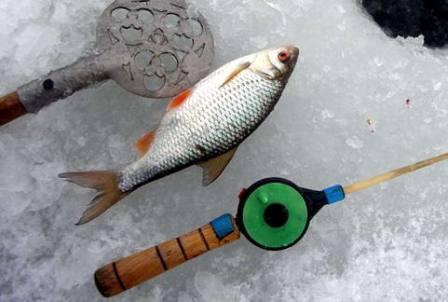
Fly for catching winter predator
Fishing for me has long ceased to be about catching fish. A favorite hobby has grown into a way of life. A deeper study of the habits of fish, its reactions to different colors, shapes, sizes and smells of baits has given rise to new unconventional approaches to fishing. This is how fly fishing flies appeared in my arsenal. What is the advantage of these sophisticated baits and are they really better for catching fish?
Perch
I have always caught perch using a balance beam and a reelless bait. With a balancer, be sure to use a hanging tee with a bright drop or cambric. But at the same time, there were often idle bites, disappearances, or the fish did not bite at all, although it was felt that there was one under the hole. On one of these fishing trips, I remembered that perch, especially passive ones, do not attack, but, approaching the bait, try to pull it into the mouth using the movements of the gill covers. The light bait easily flies into the mouth of the fish, and the angler feels the bite. If the bait is heavy, then the predator is not able to retract it and quickly loses interest in it. Often, only the hanging tee gets into the fish's mouth.
Read: Fly fishing for perch
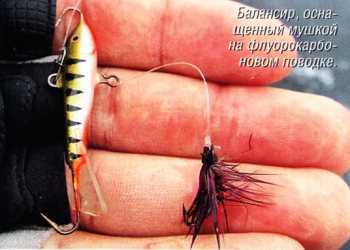
To increase the chances of a confident bite and catching a fish, I tried tying a fly on a single hook and hanging it from a balancer on a fluorocarbon leash 3-5 cm long.
This type of suspension attracts fish by the residual movement and movement of hairs during a pause.
In a similar way, a vertical spoon is equipped with a tee on a chain. On the balancer, the chain often gets caught behind the body, so I abandoned it. But the option with a suspended fly successfully passed the fishing test: there were no overlaps, and the number of bites realized was significantly greater than in the option with a tee. In addition, the fly holds liquid attractants well, which in winter, as it turns out, also increase the number of bites.
Something similar happened with the reelless jig. By tying a fly on it, I got an excellent imitation of a fry and the opportunity to use an attractant. In addition, a soft, shaggy bait attracts perch better and provokes it to attack.
From the practice of fly fishing and winter jig fishing, I noticed that perch like lures of dark colors with shine and the presence of a bright element - the point of attack. Therefore, for tying flies I use dark green, shiny peacock feather beards. The fly turns out to be fluffy, and the bright yellow or orange tail makes the bait even more attractive. I make eyes on the head of the jig, and knit the collar of the fly from shiny fibers. If you watch such a jig in the water, it becomes clear why perch cannot pass by such a “miracle”.
Read: Mormyshka crap: how to make a reelless jig with your own hands
Pike and zander
As it turned out, in winter not only perch, but also pike respond well to different odors that are applied to the bait. The balancer is a solid bait, and any attractant is quickly washed off from it. Therefore, I decided to replace the hanging treble with a double hook with a long shank on which the fly is tied. The use of a double suspended with hooks back (towards the tail of the balancer) is important in strong places - the number of hooks is much less than in the version with a tee. And the attractant can be applied not to the body of the bait, but to the fly.
I catch another predator of our waters - pike perch - with balance beams, and less often - with vertical spoons. Pike perch is also very interested in bait that has a smell. And the fly, tied on the hook of a balancer or spinner, holds the liquid attractant well and attracts pike perch with its shaggy appearance and the play of hairs in the current. This interesting and simple tuning of baits provides good fishing results. I advise you to try it too!
Front sights
How to catch roach with a jig at different times of the year
When there is first ice, the track is kept at shallow depths, no more than three meters. In these places, it often creates a campaign for perches. This period is marked by its active movement in search of food supply. Flocks can accumulate in some areas near underwater vegetation or snags.
With the onset of mid-winter, the sorog gradually moves to the depths, exchanging the campaign of perches for underbreeders, however, even there it leads a fairly active lifestyle until the wilderness sets in. At this time, it is almost impossible to catch roaches, as they stand in the pits.
Catching roach with a jig in the spring is most successful, since the fish enters the stage of an active lifestyle. This happens with the beginning of snow melting, and a change from complete lack of bites in one day can be replaced by continuous bites. Soroga comes out of his stupor immediately and unexpectedly.
Several ways to increase the catchability of bait:
- You can attach small antennae to the shank of the hook, which will move when played. To do this, knit red and black threads, cutting them to the required length. Usually half a millimeter is enough.
- Large roaches prefer baits coated with colorless varnish with glitter. As a rule, an ant is coated with this composition, but experiments can be carried out with other forms.
- In winter, you need to experiment more not only with the type of wiring, but also with baits. If the jig begins to ignore the bait, you need to tie on another jig.
- Changing the color of the weight and even the beads on the forend is easy with the help of a marker, which is a must-have for any fishing trip. It often happens that it is enough to change the bead on the hook.
Proper roach fishing technique
By playing with bait in different water horizons, fishermen achieve such a manner that it is as similar as possible to the movements of an insect or its inhabitant that has fallen into a reservoir, which we wrote about in the article “What kind of jig is used to catch bream in winter and methods of fishing for it.”
To interest the roach, use the following technique:
- The bait is raised above the ground of the reservoir by 5-10 centimeters and the fish are teased with small oscillatory movements. This game can be used in all water levels.
- They tap the jig on the bottom several times to muddy the water a little, and make oscillatory movements in the horizontal plane, moving the line from one edge of the hole to the other.
Any jig fishing for roach often involves using baits. Not only do bloodworms have many advantages when catching any fish; maggots have proven themselves to be an excellent alternative. On the hook it behaves actively, lasts a long time and, from the point of view of the fish, is very appetizing.
If we talk about bloodworms, they work well in the dead of winter. It is possible to make a sandwich by alternating maggots with weevil mosquito larvae. Bait plays virtually no role when catching sorog, although many anglers would argue with this. A school of fish moves through a body of water according to some laws known only to it.
To begin with, drill 5-10 holes at a distance from each other. The area can be fed with ground breadcrumbs mixed with food bloodworms. Using a fishing rod, you can look at the unevenness of the bottom of the reservoir, marking the most promising places. Now every hole is fished.
It is preferable to start fishing with reelless baits. Once they feel a bite, they try different bait options. Idle wells are supplemented with food. If this does not help, you will have to drill new holes in the ice. You should not immediately empty the catchable area; after catching several roaches, feed the hole and let it rest.
Which jig is better for roach - reelless or with a nozzle - you can’t answer that easily. The nozzle allows you to play along the entire vertical of the reservoir, but it requires continuous work with a fishing rod. Such monotony is tiring, so if possible, baits should be alternated.
Disadvantages and advantages of artificial flies
Artificial baits in the form of flies have versatility in their use. In addition, they are convenient to work with, and you can catch both predatory and peaceful fish. You can find several main types of artificial baits of this type.
Wet flies
They imitate drowned insects. They are distinguished by a thinner body, as well as the presence of legs and a tail. Typically, fly fishermen use such flies to catch fish such as grayling or salmon.
Dry flies
These baits imitate adult flies, gadflies, dragonflies, etc., which somehow ended up in the water. Non-sinking materials are used for their manufacture, so such flies are always on the surface of the water. They are made on the basis of thin hooks so that the bait has minimal weight. Roach, rudd, chub, etc. react to such baits.
They look like underwater insects in development. They are good for catching grayling and salmon. The more believably the fly imitates an insect, the more effective the fishing will be.
Emergers
A special type of bait that imitates insects that are at the stage of turning a pupa into a full-fledged individual.
Streamers
This bait differs in that it resembles a fish fry, which is used to catch predatory fish, such as grayling. Such flies are very difficult to make, as they require special skill. As a rule, such a fly is used for catching predatory fish.
Artificial flies have a number of advantages compared to other types of bait. They are simple, reliable and, at the same time, versatile, which allows them to be used for catching almost all types of fish. Moreover, flies are durable, so you can provide yourself with such baits for a long time if you make them yourself.
Another factor that is decisive when making them yourself is the low quality of flies purchased in the retail chain. Of course, you can find branded copies of well-known companies, but they are quite expensive, although they are catchy.
Many fishermen buy store-bought products, but most try to make them themselves, especially since, apart from a hook, nothing in short supply is required. All that is required is desire and perseverance, since making some flies takes quite a lot of time.
In addition, you will need a creative approach, otherwise you will not be able to tie a good, high-quality fly.
Artificial flies have one single drawback, which boils down to the fact that you need to spend a lot of time learning how to tie really catchy baits. Despite the apparent simplicity, one initially gets the impression that everything is really very simple.
Unfortunately, it’s just everything for those who do nothing. As for fly tying, it is responsible, meticulous and hard work.
In addition, this process is quite interesting, just like the fishing process itself. Real enthusiastic fishermen prefer baits made with their own hands in a home workshop.
Oddly enough, such baits are more catchy than some specimens, especially cheap copies that are sold in fishing stores. This speaks of a creative approach and high craftsmanship, especially since every fisherman is very interested in seeing how his work of art works.
Making bait at home is not very expensive in a financial sense, so it is accessible to almost every fisherman who wants it. The main thing is to be patient and allocate some of your personal time.
Types of jigs
Jigs for depth 0–1.5 m
Deep baits are used in reservoirs up to 1.5 meters deep. The weight of such a jig ranges from 0.1 to 0.3 grams. It is advisable to equip the bait with a bright 0.1 mm red or orange bead. You can fish without bait or attach bloodworms. The “Kapelka” and “Ant” jigs are considered the most catchy at this depth.
“Droplet” is designed for deep use. They are made mainly from brass and lead. Some believe that the “Droplet” seduces fish with its yellow color, others believe that, thanks to its shape, it creates a cloud that attracts fish. These assumptions do not have any good reason; one thing remains unchanged: the roach likes “Droplet”.
The “Ant” is shaped like an insect; when played with a nod, the jig makes horizontal oscillations, reminiscent of the movements of an insect, which lures the fish.
Jigs made of heavy alloys for 4–6 m
It is preferable to make jigs for fishing at a depth of 4–6 meters from lead. The most popular types of heavy baits include:
- "Uralka". In its appearance it resembles a “Droplet”, but its end is curved like the lower part of the body of an insect larva, which attracts roaches.

Mormyshka - Uralka
- A “pellet” is simply a ball with a diameter of 2.5–5 mm made of lead, brass and other silver-colored alloys. “Drobinka” is covered with black paint, brightly colored varnishes and light-accumulating compounds.
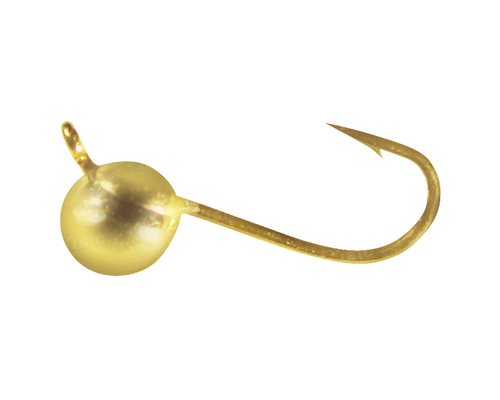
Mormyshka - pellet
- "Worm". To make this jig, copper, brass or silver wire (can be used from guitar strings) is wound around the pointed tip of the stick. You need to wind as much as is required to create a jig of the desired size. Having removed the resulting spiral from the stick, a tin-plated hook is inserted into it. The needle is fixed between the turns of the spiral to hold the workpiece in the desired position when soldering, and lead is soldered throughout the spiral. After cooling, the jig is refined with a file. At the place where the needle was inserted, there remains a hole for threading the fishing line.
The finished bait looks like a piece of dung worm with a very believable imitation of its rings.
Heavy jigs made of lead or tungsten
- Lead jigs for fishing at depth are made with a large diameter (from 4 mm). If you don’t have any of these in stock, but you really want to fish at depth, you can tie 2 lead jigs of 2 grams each to the fishing line.
- Tungsten jigs with the same dimensions as lead jigs will be heavier, since the specific gravity of tungsten is greater than the specific gravity of other metals. The silvery color of tungsten is noticeable to fish even in gloomy weather. Often tungsten baits are additionally colored, which makes them more attractive to roaches.
It is very difficult to make a tungsten jig yourself, since tungsten is difficult to heat and mechanically treat.
General requirements
Roach is a peaceful fish that feeds on food of plant and animal origin. Its diet is based on various larvae of semi-aquatic insects, benthic invertebrates, phytoplankton and filamentous algae. This diversity allows it to survive in any situation, regardless of the time of year.
The jig, naturally, is of increased interest to roaches, since it is associated with small underwater insects or larvae. The fish responds well to this bait, especially when the angler managed to select the optimal model and present it correctly.
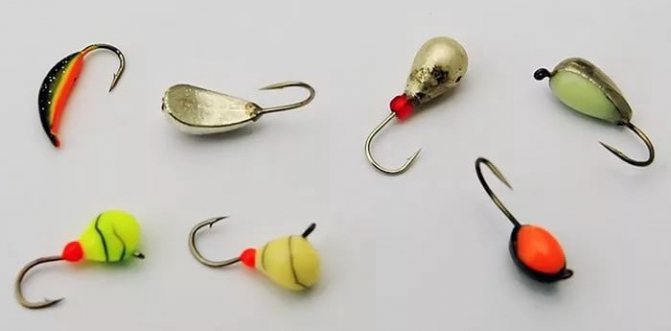
Jigs for fishing with bloodworms
If with jigs for roach using bloodworms everything is very clear, since their main function is to deliver the bait to the fishing point, and the game itself and appearance are secondary, then reelless models require a serious approach in which trifles do not exist.
Choosing a jig for catching roach
Criterias of choice
When choosing a jig for catching roach, the following criteria are taken into account:
- Fishing season;
- Depth;
- Presence and strength of current;
- Weather;
- Illumination;
- Fish activity.
Also, in addition to these criteria, the specific features of individual reservoirs are taken into account, in which fish can, contrary to all recommendations, be successfully caught using bait of a certain model, while ignoring all others.
Jigs for ice fishing
In winter, roaches are caught using small and medium-sized bait and reelless jigs of the following models:
- "Uralka";
- "Nymph";
- "Ant";
- "A drop";
- "Pellet";
- "Ovsinka";
- "Goat";
- "Bug."
For fishing in reservoirs with depths above 4-5 m, larger tungsten baits of colors weighing 0.3-0.4 g are used. For fishing in smaller lakes, ponds, small rivers, where the depth at the fishing site does not exceed 3- 3.5 meters, use small attachments and reelless lead and tungsten jigs weighing 0.1-0.2 g.
Uralka (click to enlarge)

Nymph

Ant
The choice of jig color depends on the period of ice fishing, depth and light:
- Lures of golden and silver colors are used in cloudy weather and on the first ice, the last ice at depths of up to 2.5-3 meters;
- Jigs of a dull bronze color and dark colors are suitable for catching roach in dry winter conditions at depths of more than 4 meters, as well as in conditions of first ice and sunny weather in shallow (up to 2 meters) areas;
- Lures of bright colors, as well as those with a luminous (fluorescent) coating, are used for catching roach in the middle of winter in deep holes, in the morning or evening twilight.
For summer fishing
For summer fishing, larger analogues of winter models are used such as:
- "Uralka";
- "Ant";
- "Pellet";
- "A drop";
- "Ovsinka";
- "Klopik";
- "Cone".
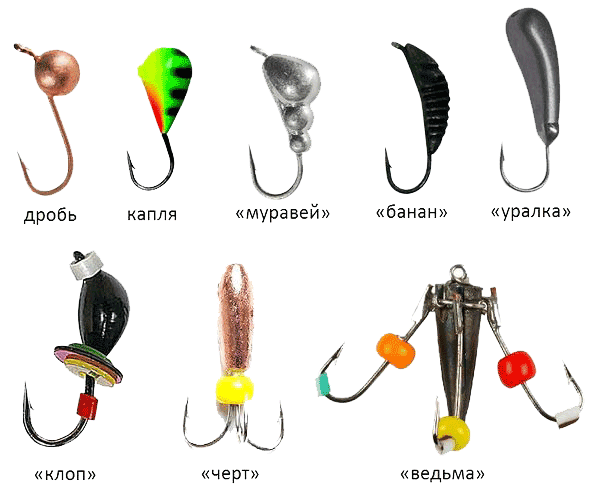
The weight of such baits ranges from 0.4-0.5 g for fishing in shallow waters and weak currents. Up to 1-1.5 g for depths over 4 meters and areas with medium and fast currents.
The choice of summer jig color depends on the time of year, weather conditions and fish activity:
- Shiny baits of golden or silver color are used for catching active roach in early spring in the coastal zone with depths of up to 2.5-3 m. Also, such jigs “work well” in cloudy weather and after prolonged heavy rains, when the water is cloudy and visibility is limited. .
- Dark, bronze or copper colored jigs are used in clear sunny weather in summer and autumn to catch roach at depths of over 3-4 meters.
Rarely found summer jigs of acidic colors are used for passive and low-active fishing in pools and pits.
